Stretching exercises are sometimes referred to as warm-up or cool-down exercises. Do not confuse stretching exercises with your cardiovascular warm-up and cool-down exercises.
Stretching your muscles (flexibility training) is an important part of staying fit. Stretching improves the flexibility of your muscles and reduces the risk of injury when doing aerobic and resistance training.
Static stretching involves holding a position for a period of time. It is important to do at least 5 minutes of cardiovascular warm-up before stretching a muscle. A good time to stretch is after your aerobic training, when your muscles are already warm.
Learn what to do for a cardiovascular warm-up »
How Do I Stretch?
To do a static stretch, stretch to the farthest point you comfortably can. You should feel tightness, but the stretch should not cause pain or discomfort in the muscle. Hold the stretch while continuing to breathe for 15-30 seconds.
- Remember not to bounce or change position while you are holding the stretch.
Stretching exercises
Below is a series of upper and lower body stretches you can include in your exercise routine.
|
Chest Stretch (Pectoral Muscle) |
|---|
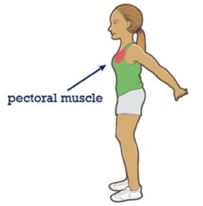
Pectoral muscle. This is where you should feel the stretch when you do a chest stretch. - Stand with your feet shoulder width apart.
- Relax your shoulders and make sure they are not hunched up.
- Clasp your hands behind your back. If you cannot clasp them, then place them behind your back.
- Looking straight ahead, open up the chest and squeeze your shoulder blades together.
- Hold the stretch while continuing to breathe for 15-30 seconds.
- Ensure you feel a stretch, not pain/discomfort.
|
|
Shoulder Stretch (Deltoid Muscle) |
|---|
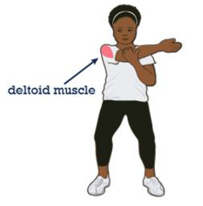
Deltoid muscle. This is where you should feel the stretch when you do a shoulder stretch. - Stand with your feet shoulder width apart, arms by your side.
- Relax your shoulders and make sure they are not hunched up.
- Take one arm and bring it across your chest.
- Take the other arm and place it on your elbow to help hold it in position.
- Ensure your arm is across your chest and not across your neck.
- Hold the stretch while continuing to breathe for 15- 30 seconds.
- Ensure you feel a stretch, not pain/discomfort.
- Repeat to stretch the opposite shoulder.
|
|
Thigh Stretch (Quadriceps Muscle) |
|---|
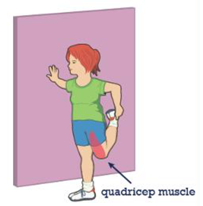
Quadriceps muscle. This is where you should feel the stretch when you do a thigh stretch. - Using a wall for support, stand sideways to the wall.
- Take hold of your ankle, foot, sock, or pant leg as you bend your leg back from the knee (see figure).
- The knee should be facing down toward the floor and in line with the leg that is planted on the floor.
- Hold the stretch while continuing to breathe for 15-30 seconds.
- Ensure you feel a stretch, not pain/discomfort.
- Repeat to stretch the opposite thigh.
|
|
Hamstring Stretch |
|---|
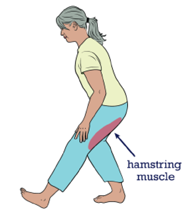
Hamstring muscle. This is where you should feel the stretch when you do a hamstring stretch. - Using a wall or table for support, stand sideways to it.
- Put all of your body weight on one leg and bend that leg.
- Take the opposite leg and place the heel on the floor or on a small step with the toes pointed up. Keep this leg straight.
- From this position, bend forward from the waist – you will feel a stretch in the back of the upper leg that is straight.
- Hold the stretch while continuing to breathe for 15-30 seconds.
- Ensure you feel a stretch, not pain/discomfort.
- Repeat to stretch the opposite hamstring.
|
|
Calf Stretch |
|---|
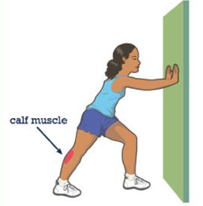
Calf muscle. This is where you should feel the stretch when you do a calf stretch. - Using a wall for support, face the wall standing with both feet close to it. Place your hands on the wall at chest height.
- Take a step back with one leg keeping that leg straight and lean into the wall keeping the front leg bent.
- Ensure both feet are facing forward.
- As you lean into the wall, you will feel a stretch in the calf of the back leg.
- Hold the stretch while continuing to breathe for 15-30 seconds.
- Ensure you feel a stretch, not pain/discomfort.
- Repeat to stretch the opposite calf.
|
